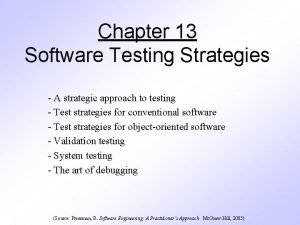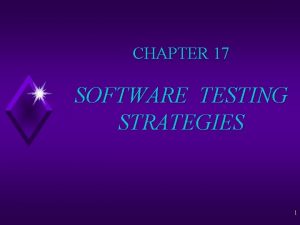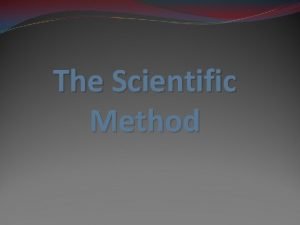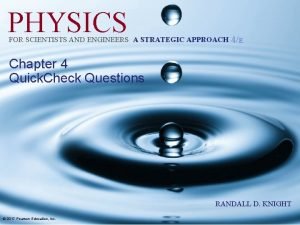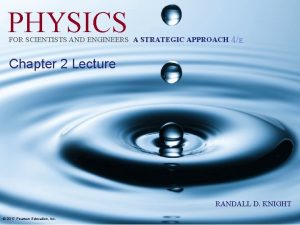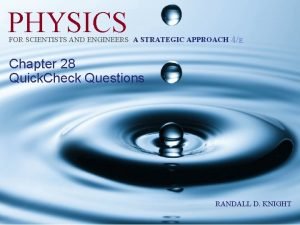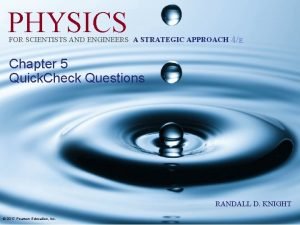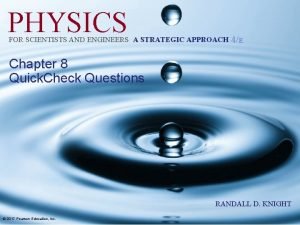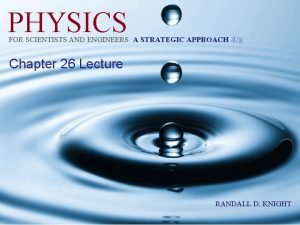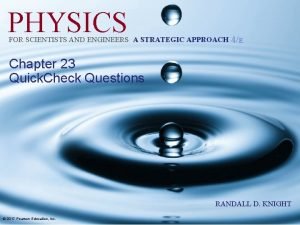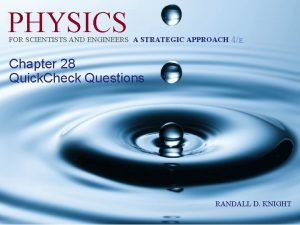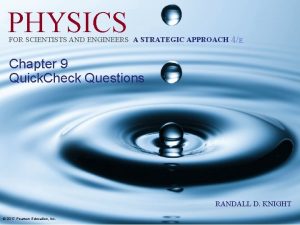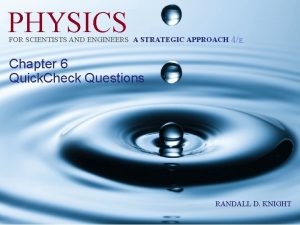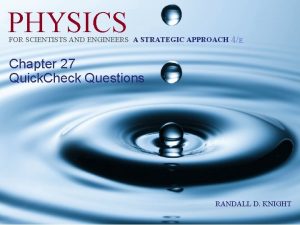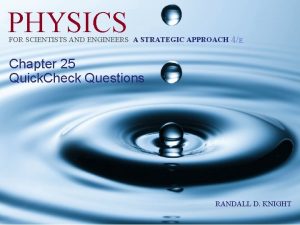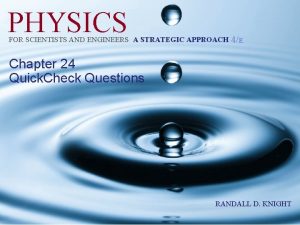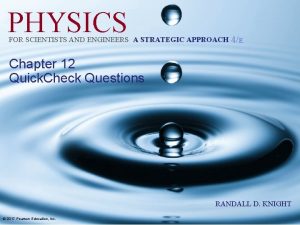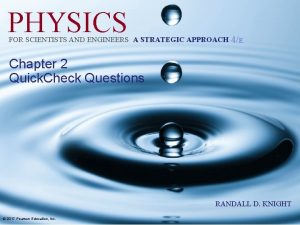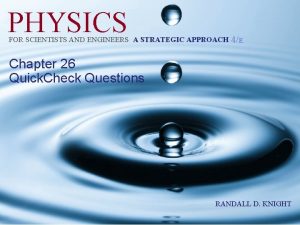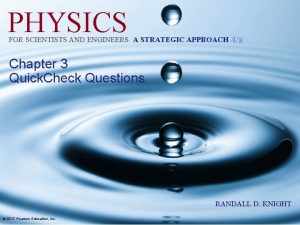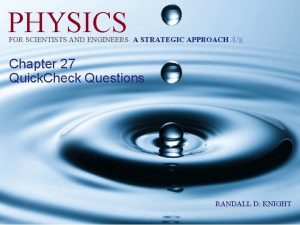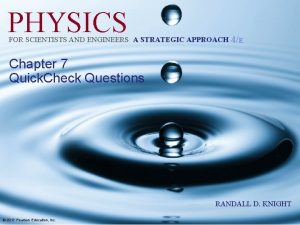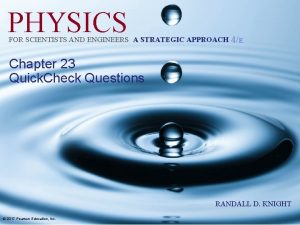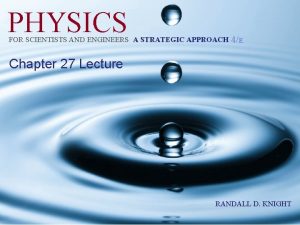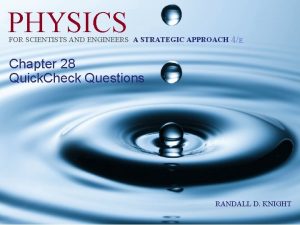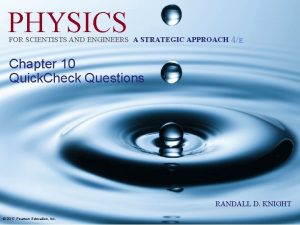PHYSICS FOR SCIENTISTS AND ENGINEERS A STRATEGIC APPROACH































- Slides: 31

PHYSICS FOR SCIENTISTS AND ENGINEERS A STRATEGIC APPROACH 4/E Chapter 15 Quick. Check Questions RANDALL D. KNIGHT © 2017 Pearson Education, Inc.

Quick. Check 15. 1 Which oscillation (or oscillations) is SHM? D. A and B but not C. E. None are. © 2017 Pearson Education, Inc. Slide 15 -2

Quick. Check 15. 1 Which oscillation (or oscillations) is SHM? D. A and B but not C. E. None are. © 2017 Pearson Education, Inc. Slide 15 -3

Quick. Check 15. 2 This is the position graph of a mass oscillating on a horizontal spring. What is the phase constant ϕ 0? A. –π/2 rad B. 0 rad C. π/2 rad D. π rad E. None of these © 2017 Pearson Education, Inc. Slide 15 -4

Quick. Check 15. 2 This is the position graph of a mass oscillating on a horizontal spring. What is the phase constant ϕ 0? A. –π/2 rad B. 0 rad C. π/2 rad D. π rad E. None of these © 2017 Pearson Education, Inc. Initial conditions: x=0 vx > 0 Slide 15 -5

Quick. Check 15. 3 This is the position graph of a mass oscillating on a horizontal spring. What is the phase constant ϕ 0? A. –π /2 rad B. 0 rad C. π /2 rad D. π rad E. None of these © 2017 Pearson Education, Inc. Slide 15 -6

Quick. Check 15. 3 This is the position graph of a mass oscillating on a horizontal spring. What is the phase constant ϕ 0? A. –π /2 rad B. 0 rad C. π /2 rad D. π rad E. None of these © 2017 Pearson Education, Inc. Initial conditions: x = –A vx = 0 Slide 15 -7

Quick. Check 15. 4 The figure shows four oscillators at t = 0. For which is the phase constant ϕ 0 =–π /4? © 2017 Pearson Education, Inc. Slide 15 -8

Quick. Check 15. 4 The figure shows four oscillators at t = 0. For which is the phase constant ϕ 0 =–π /4? Initial conditions: x = 0. 71 A vx > 0 © 2017 Pearson Education, Inc. Slide 15 -9

Quick. Check 15. 5 A block oscillates on a very long horizontal spring. The graph shows the block’s kinetic energy as a function of position. What is the spring constant? A. B. C. D. E. 1 N/m 2 N/m 4 N/m 8 N/m I have no idea. © 2017 Pearson Education, Inc. Slide 15 -10

Quick. Check 15. 5 A block oscillates on a very long horizontal spring. The graph shows the block’s kinetic energy as a function of position. What is the spring constant? A. B. C. D. E. 1 N/m 2 N/m 4 N/m 8 N/m I have no idea. © 2017 Pearson Education, Inc. Slide 15 -11

Quick. Check 15. 6 A mass oscillates on a horizontal spring with period T = 2. 0 s. If the amplitude of the oscillation is doubled, the new period will be A. 1. 0 s B. 1. 4 s C. 2. 0 s D. 2. 8 s E. 4. 0 s © 2017 Pearson Education, Inc. Slide 15 -12

Quick. Check 15. 6 A mass oscillates on a horizontal spring with period T = 2. 0 s. If the amplitude of the oscillation is doubled, the new period will be A. 1. 0 s B. 1. 4 s C. 2. 0 s D. 2. 8 s E. 4. 0 s © 2017 Pearson Education, Inc. Slide 15 -13

Quick. Check 15. 7 A block of mass m oscillates on a horizontal spring with period T = 2. 0 s. If a second identical block is glued to the top of the first block, the new period will be A. 1. 0 s B. 1. 4 s C. 2. 0 s D. 2. 8 s E. 4. 0 s © 2017 Pearson Education, Inc. Slide 15 -14

Quick. Check 15. 7 A block of mass m oscillates on a horizontal spring with period T = 2. 0 s. If a second identical block is glued to the top of the first block, the new period will be A. 1. 0 s B. 1. 4 s C. 2. 0 s D. 2. 8 s E. 4. 0 s © 2017 Pearson Education, Inc. Slide 15 -15

Quick. Check 15. 8 Two identical blocks oscillate on different horizontal springs. Which spring has the larger spring constant? A. The red spring B. The blue spring C. There’s not enough information to tell. © 2017 Pearson Education, Inc. Slide 15 -16

Quick. Check 15. 8 Two identical blocks oscillate on different horizontal springs. Which spring has the larger spring constant? A. The red spring B. The blue spring C. There’s not enough information to tell. © 2017 Pearson Education, Inc. Slide 15 -17

Quick. Check 15. 9 A mass oscillates on a horizontal spring. It’s velocity is vx and the spring exerts force Fx. At the time indicated by the arrow, A. vx is + and Fx is +. B. vx is + and Fx is –. C. vx is – and Fx is 0. D. vx is 0 and Fx is +. E. vx is 0 and Fx is –. © 2017 Pearson Education, Inc. Slide 15 -18

Quick. Check 15. 9 A mass oscillates on a horizontal spring. It’s velocity is vx and the spring exerts force Fx. At the time indicated by the arrow, A. vx is + and Fx is +. B. vx is + and Fx is –. C. vx is – and Fx is 0. D. vx is 0 and Fx is +. E. vx is 0 and Fx is –. © 2017 Pearson Education, Inc. Slide 15 -19

Quick. Check 15. 10 A mass oscillates on a horizontal spring. It’s velocity is vx and the spring exerts force Fx. At the time indicated by the arrow, A. vx is + and Fx is +. B. vx is + and Fx is –. C. vx is – and Fx is 0. D. vx is 0 and Fx is +. E. vx is 0 and Fx is –. © 2017 Pearson Education, Inc. Slide 15 -20

Quick. Check 15. 10 A mass oscillates on a horizontal spring. It’s velocity is vx and the spring exerts force Fx. At the time indicated by the arrow, A. vx is + and Fx is +. B. vx is + and Fx is –. C. vx is – and Fx is 0. D. vx is 0 and Fx is +. E. vx is 0 and Fx is –. © 2017 Pearson Education, Inc. Slide 15 -21

Quick. Check 15. 11 A block oscillates on a vertical spring. When the block is at the lowest point of the oscillation, it’s acceleration ay is A. Negative. B. Zero. C. Positive. © 2017 Pearson Education, Inc. Slide 15 -22

Quick. Check 15. 11 A block oscillates on a vertical spring. When the block is at the lowest point of the oscillation, it’s acceleration ay is A. Negative. B. Zero. C. Positive. © 2017 Pearson Education, Inc. Slide 15 -23

Quick. Check 15. 12 A ball on a massless, rigid rod oscillates as a simple pendulum with a period of 2. 0 s. If the ball is replaced with another ball having twice the mass, the period will be A. 1. 0 s B. 1. 4 s C. 2. 0 s D. 2. 8 s E. 4. 0 s © 2017 Pearson Education, Inc. Slide 15 -24

Quick. Check 15. 12 A ball on a massless, rigid rod oscillates as a simple pendulum with a period of 2. 0 s. If the ball is replaced with another ball having twice the mass, the period will be A. 1. 0 s B. 1. 4 s C. 2. 0 s D. 2. 8 s E. 4. 0 s © 2017 Pearson Education, Inc. Slide 15 -25

Quick. Check 15. 13 On Planet X, a ball on a massless, rigid rod oscillates as a simple pendulum with a period of 2. 0 s. If the pendulum is taken to the moon of Planet X, where the free-fall acceleration g is half as big, the period will be A. 1. 0 s B. 1. 4 s C. 2. 0 s D. 2. 8 s E. 4. 0 s © 2017 Pearson Education, Inc. Slide 15 -26

Quick. Check 15. 13 On Planet X, a ball on a massless, rigid rod oscillates as a simple pendulum with a period of 2. 0 s. If the pendulum is taken to the moon of Planet X, where the free-fall acceleration g is half as big, the period will be A. 1. 0 s B. 1. 4 s C. 2. 0 s D. 2. 8 s E. 4. 0 s © 2017 Pearson Education, Inc. Slide 15 -27

Quick. Check 15. 14 A solid disk and a circular hoop have the same radius and the same mass. Each can swing back and forth as a pendulum from a pivot at one edge. Which has the larger period of oscillation? A. The solid disk B. The circular hoop C. Both have the same period. D. There’s not enough information to tell. © 2017 Pearson Education, Inc. Slide 15 -28

Quick. Check 15. 14 A solid disk and a circular hoop have the same radius and the same mass. Each can swing back and forth as a pendulum from a pivot at one edge. Which has the larger period of oscillation? A. The solid disk B. The circular hoop C. Both have the same period. D. There’s not enough information to tell. © 2017 Pearson Education, Inc. Slide 15 -29

Quick. Check 15. 15 The graph shows how three oscillators respond as the frequency of a driving force is varied. If each oscillator is started and then left alone, which will oscillate for the longest time? A. The red oscillator B. The blue oscillator C. The green oscillator D. They all oscillate for the same length of time. © 2017 Pearson Education, Inc. Slide 15 -30

Quick. Check 15. 15 The graph shows how three oscillators respond as the frequency of a driving force is varied. If each oscillator is started and then left alone, which will oscillate for the longest time? A. The red oscillator B. The blue oscillator C. The green oscillator D. They all oscillate for the same length of time. © 2017 Pearson Education, Inc. Slide 15 -31
 Bertrand strategic complements
Bertrand strategic complements Strategic management and strategic competitiveness
Strategic management and strategic competitiveness Tows matrix
Tows matrix Example of virtual circuit network
Example of virtual circuit network Deep learning approach and surface learning approach
Deep learning approach and surface learning approach Strategic fit vs strategic intent
Strategic fit vs strategic intent Incremental approach in strategic management
Incremental approach in strategic management Strategic control and corporate governance
Strategic control and corporate governance Strategic choice approach
Strategic choice approach A strategic approach to software testing
A strategic approach to software testing Strategic management a competitive advantage approach
Strategic management a competitive advantage approach A strategic approach to software testing
A strategic approach to software testing Commander approach in strategic management
Commander approach in strategic management Sometimes scientists make a mistake or
Sometimes scientists make a mistake or Diagrams tables and graphs are used by scientists mainly to
Diagrams tables and graphs are used by scientists mainly to Modern physics vs classical physics
Modern physics vs classical physics University physics with modern physics fifteenth edition
University physics with modern physics fifteenth edition Physics ia exemplars
Physics ia exemplars Formuö
Formuö Typiska novell drag
Typiska novell drag Nationell inriktning för artificiell intelligens
Nationell inriktning för artificiell intelligens Ekologiskt fotavtryck
Ekologiskt fotavtryck Varför kallas perioden 1918-1939 för mellankrigstiden?
Varför kallas perioden 1918-1939 för mellankrigstiden? En lathund för arbete med kontinuitetshantering
En lathund för arbete med kontinuitetshantering Underlag för särskild löneskatt på pensionskostnader
Underlag för särskild löneskatt på pensionskostnader Tidbok
Tidbok Anatomi organ reproduksi
Anatomi organ reproduksi Förklara densitet för barn
Förklara densitet för barn Datorkunskap för nybörjare
Datorkunskap för nybörjare Tack för att ni lyssnade bild
Tack för att ni lyssnade bild Hur skriver man en tes
Hur skriver man en tes Autokratiskt ledarskap
Autokratiskt ledarskap









